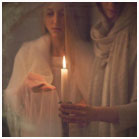|
DANU, MODRON,
MORGAINE AND ANNA – THE PRIMEVAL MOTHER?
(© Arianrhod SilverWheel)
According to the “Trioedd
Ynis Prydein”, Afallach – son of Anu or Dôn, a
primeval goddess similar to the Irish Danu,
ancestress of the Tuatha de’ Dannan – used to
live on the Isle of Avalon (Ynis Afallach),
ruling on it with his nine daughters. The most
important of them was Modron.
The nine sisters were
keepers of a treasure of the kingdom of Annwn
(the Otherworld): the Cauldron. In his “Vita
Merlini” Geoffrey of Monmouth affirms, instead,
that the island was ruled by the nine sisters,
and that the most powerful among them was Morgan
or Morgaine.
Let’s analyze now the name
AFALLACH (or Avallach, or Avlach). Afallach and
Avalon are related to the APPLE: aval in Welsh
and Breton, avallo in Gaulish, ubull in ancient
Irish, apple in English, from the
Proto-Indoeuropean root *ab(e)l (= apple).
Jean Markale writes that
“in the Irish legend of the Island of Women… it
was knwn as Emain Ablach, of which the poets
praised its apple-trees and the beauty of their
fruits. According to
Pliny the Elder (Historia Naturalis, XXXVIII,
35) the Teutons… traded in amber with the
inhabitants of the island of Abalum (today Oesel),
East of the Baltic. There was a village called
Aboul on that island and its name, together with
that of Abalum and of the Italian island of
Abella Melifera, had the same roots Avalon”.
Mabon or Maponos (= Son), a
god of youth, is Modron’s son. Modron and Mabon
are comparable to the figure of the Mother
Goddess and her Divine Son like Isis/Horus, the
Virgin Mary/Christ, Demeter/Persephone, Rhiannon/Pwyll
etc. Her name recalls that of Matrona, a
Roman-Briton goddess, and of Saint Madrun, a
princess niece of Vortigern whose sister’s and
maid’s names were (accidentally?) Anne and Saint
Annun. Moreover, being both related to the
island of Avalon, we can also assume a link (or
a superimposition) between the figure of Modron
and that of Morgan Le Fay (Morgaine). The last
one being a mutation of the name Modron, for the
first mention of Morgaine dates at the times of
the medieval Arthurian novels.
We know that the Primeval
Mother, or the Great Goddess, in many cultures
is linked to water (of which the island, the
boat, the cup, the cauldron, the well etc. are
symbols) and, through it, to gestation, birth
and creation (just think about the waters of
birth: the deluge that sets apart the newborn
from the divine to throw him/her into the human
world). According to Markale the novelty of
Morgaine’s character comes “from the name, that
does not appear in any Welsh tale, except that
in the masculine form Morgantut, Arthur’s doctor
and wizard, mentioned in Kulwch and Olwen. In
Breton folklore we have Mary-Morgan, a kind of
mermaid linked to water… her name means born of
the sea (mori genos, Irish muir gen). She’s a
Mother Goddess… not of one or more goddesses of
fertility… but of the myth of primordial
divinity...”.
The hypothesis Modron =
Morgaine could be proved by the fact that Sir
Thomas Malory (“Le Morte d’Arthur”) describes
the last one as the wife of Urien Rheged, a king
from the Northern lands. In Welsh tradition his
wife’s name was Modron ferch Afallach. In
addition, Britannia.com affirms that “we can
suppose that the story of the incest with Arthur
(after which Mordred was born) is the result of
an overlapping of the figure of Morgaine on her
sister (Anna-)Morgause.
In Chrétien de Troyes’
“Perceval” (Anna-)Morgause is called Morcades.
This could be an epithet: Orcades was the Latin
name of the Orkney Islands, residence of king
Lot and his wife Anna. From here, we can
suppose, the name Anna Morcades/Morgause: Anna
of the Orcades.
Resuming what we have
analyzed so far, we can assert that the above
characters are linked to the water element, and
from it to creation. In Proto-Indoeuropean the
term for river was *danu, a root found in the
names of the great European rivers such as Don,
Dniepr, Danube etc. The Celtic tribes that
invaded Europe were part of the Indoeuropean
family. In Hindu mythology (Rig Veda) we can see
a goddess Danu, her name meaning heavenly waters
(or spring), and in Sanskrit anna means
nourishment.
Concluding, I’m adding a
list of divine names from different pantheons
and languages that, in my opinion, could be
related to the term *danu.
Nun: in Egyptian tradition
the name of the Primordial Ocean.
Nûn: the 14th letter of the
Arabic alphabet. It represents the Whale. The
Arabic word nûn means fish.
Aná-hita: water and
fertility goddess of Iranian mythology.
Don: ancient Schyte word
meaning water.
Imana: almighty. Fertility
goddess of Banyarwanda (Rwanda) mythology.
Hannahanna: Hittite mother
goddess.
Oannes: fish-god of
Chaldean mythology.
Manannan: Irish sea-god.
Andreus: Greek son of the
river.
Traduzione a
cura di Arianrhod Silverwheel
| ![]()


